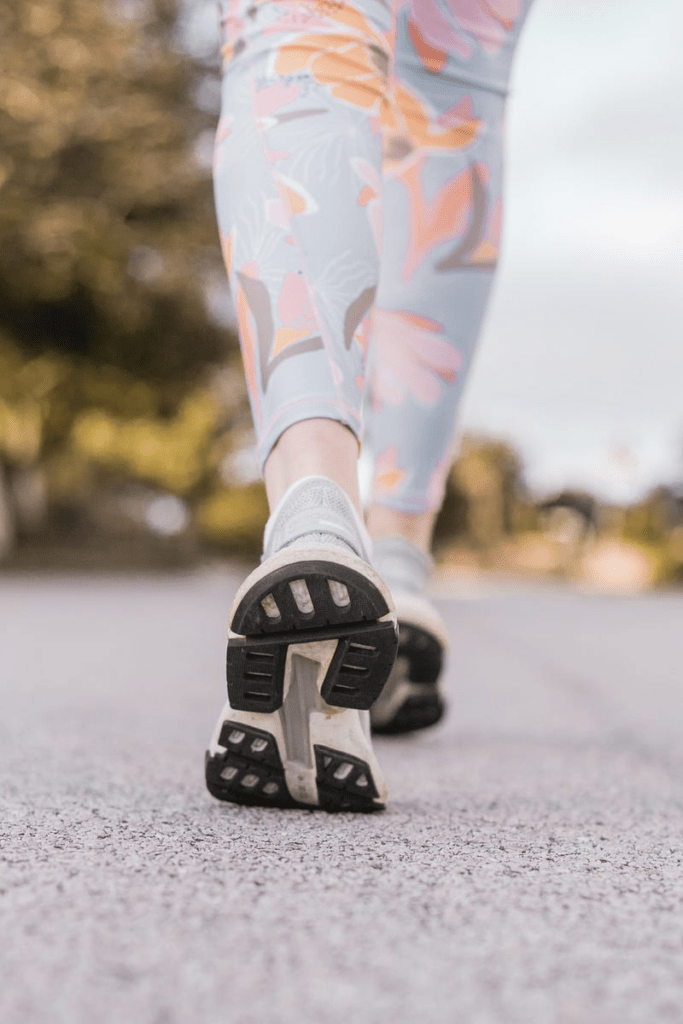Run, walk, or roll? Moving your body is key to improved mood.
When it comes to lifting your mood, medication alone is often not enough

Desperate to improve my mood and physical health, I started a running group in my community. On the first day, 12 enthusiastic neighbours joined me. Many participants hadn’t exercised regularly but felt more motivated being part of a group. Some also felt safer exercising with others, and some preferred running in the evening when it was quieter or cooler. Despite the increasingly rainy weather on the West Coast in the fall, the group initially continued to meet.
However, the numbers gradually dwindled down to just four of us (note to self: start a running group earlier in the spring!) who ran on rainy days and eventually participated together in a 5K running event.
Through this experience, I learned that consistency is key, and recruiting friends, neighbours, pets, or a professional can help you get through those tough days, whether due to the weather or low mood.
Moving your body consistently has clear benefits

A group of researchers in the Netherlands wanted to find out whether running therapy or antidepressant medication was better for treating depression. They recruited 141 patients with depression who were not taking any drugs or exercising regularly. People who didn’t have a strong preference were randomly assigned to either running therapy or antidepressant medication for 16 weeks. Others who wanted to choose their treatment were allowed to do so.
After 16 weeks, the number of people who got better from depression was similar in both groups. But, the people who did running therapy saw more health benefits. Their heart rate, waist size, and lung function improved, while the people who took antidepressants gained weight, and their heart rate variability decreased. The study suggests that running 2–3 times a week is a good way to improve depression and physical health, while taking antidepressants as a sole treatment may lead to weight gain and other negative effects.
What if I don’t like running or can’t due to physical reasons?

If you don’t like running, don’t worry. Many other types of exercise can also help improve your mental and physical health. You could try walking, cycling, swimming, dancing, yoga, or any other physical activity you enjoy. Start small and build from there. The important thing is to find an activity that you like and can do regularly to help improve your mood and overall health. Recruit friends, family, dog, or professional support to help you develop a physical activity list and schedule each step into your daily routine.
For example, research suggests that walking can effectively treat symptoms of depression. One study published in the Journal of Psychiatric Research found that walking for just 30 minutes three times a week reduced depressive symptoms in a group of older adults. Another study published in the American Journal of Preventive Medicine found that walking for 150 minutes a week, or about 30 minutes a day, was associated with a significant reduction in symptoms of depression in a large sample of adults.
Walking may help improve depression by increasing blood flow to the brain, releasing endorphins (feel-good chemicals), and reducing inflammation. Additionally, walking in nature may provide additional benefits for mental health. One study found that walking in a natural setting improved mood and self-esteem and reduced symptoms of anxiety and depression more than walking in an urban environment.
While running therapy may be effective for some people, walking is a good alternative for those who prefer lower-impact exercise or may have physical limitations. The key to tapping into the benefits of exercise in improving your mood is just to get started.
As always, it is important to consult with your healthcare provider before starting any new exercise program or changes to your treatment plan.
Still trying to figure out where to start? Check out our Couch to Consistent 5K running and walking plans!
Here’s a 9-week Couch to 5K style plan to help you gradually build your running endurance:
Week 1:
- Day 1: Alternate 60 seconds of jogging with 90 seconds of walking for a total of 20 minutes.
- Day 2: Rest
- Day 3: Alternate 60 seconds of jogging with 90 seconds of walking for a total of 20 minutes.
Week 2:
- Day 1: Alternate 90 seconds of jogging with 2 minutes of walking for a total of 20 minutes.
- Day 2: Rest
- Day 3: Alternate 90 seconds of jogging with 2 minutes of walking for a total of 20 minutes.
Week 3:
- Day 1: Alternate 3 minutes of jogging with 90 seconds of walking for a total of 25 minutes.
- Day 2: Rest
- Day 3: Alternate 3 minutes of jogging with 90 seconds of walking for a total of 25 minutes.
Week 4:
- Day 1: Alternate 5 minutes of jogging with 2 minutes of walking for a total of 30 minutes.
- Day 2: Rest
- Day 3: Alternate 5 minutes of jogging with 2 minutes of walking for a total of 30 minutes.
Week 5:
- Day 1: Jog for 20 minutes without stopping.
- Day 2: Rest
- Day 3: Alternate 8 minutes of jogging with 2 minutes of walking for a total of 30 minutes.
Week 6:
- Day 1: Alternate 10 minutes of jogging with 2 minutes of walking for a total of 30 minutes.
- Day 2: Rest
- Day 3: Alternate 10 minutes of jogging with 2 minutes of walking for a total of 30 minutes.
Week 7:
- Day 1: Jog for 25 minutes without stopping.
- Day 2: Rest
- Day 3: Alternate 12 minutes of jogging with 2 minutes of walking for a total of 35 minutes.
Week 8:
- Day 1: Alternate 15 minutes of jogging with 2 minutes of walking for a total of 40 minutes.
- Day 2: Rest
- Day 3: Alternate 18 minutes of jogging with 2 minutes of walking for a total of 45 minutes.
Week 9:
- Day 1: Jog for 30 minutes without stopping.
- Day 2: Rest
- Day 3: Run a 5K race!
Remember to stretch before and after each workout, stay hydrated, and listen to your body. If you need to repeat a week or take an extra rest day, that’s okay. The important thing is to stay consistent and gradually build up your endurance over time.
Prefer to walk? Here is a sample walking plan for beginners, modelled after the running program:
Week 1:
- Day 1: Start with a 5-minute warm-up walk. Then, alternate 1 minute of brisk walking with 1.5 minutes of easy walking for a total of 20 minutes. Finish with a 5-minute cool-down walk.
- Day 2: Rest or do some gentle stretching exercises.
- Day 3: Repeat the workout from Day 1.
Week 2:
- Day 1: Start with a 5-minute warm-up walk. Then, alternate 1.5 minutes of brisk walking with 2 minutes of easy walking for a total of 25 minutes. Finish with a 5-minute cool-down walk.
- Day 2: Rest or do some gentle stretching exercises.
- Day 3: Repeat the workout from Day 1.
Week 3:
- Day 1: Start with a 5-minute warm-up walk. Then, alternate 2 minutes of brisk walking with 2.5 minutes of easy walking for a total of 30 minutes. Finish with a 5-minute cool-down walk.
- Day 2: Rest or do some gentle stretching exercises.
- Day 3: Repeat the workout from Day 1.
Week 4:
- Day 1: Start with a 5-minute warm-up walk. Then, alternate 2.5 minutes of brisk walking with 3 minutes of easy walking for a total of 35 minutes. Finish with a 5-minute cool-down walk.
- Day 2: Rest or do some gentle stretching exercises.
- Day 3: Repeat the workout from Day 1.
Week 5:
- Day 1: Start with a 5-minute warm-up walk. Then, alternate 3 minutes of brisk walking with 3.5 minutes of easy walking for a total of 40 minutes. Finish with a 5-minute cool-down walk.
- Day 2: Rest or do some gentle stretching exercises.
- Day 3: Repeat the workout from Day 1.
Week 6:
- Day 1: Start with a 5-minute warm-up walk. Then, alternate 3.5 minutes of brisk walking with 4 minutes of easy walking for a total of 45 minutes. Finish with a 5-minute cool-down walk.
- Day 2: Rest or do some gentle stretching exercises.
- Day 3: Repeat the workout from Day 1.
Week 7:
- Day 1: Start with a 5-minute warm-up walk. Then, alternate 4 minutes of brisk walking with 4.5 minutes of easy walking for a total of 50 minutes. Finish with a 5-minute cool-down walk.
- Day 2: Rest or do some gentle stretching exercises.
- Day 3: Repeat the workout from Day 1.
Week 8:
- Day 1: Start with a 5-minute warm-up walk. Then, alternate 4.5 minutes of brisk walking with 5 minutes of easy walking for a total of 55 minutes. Finish with a 5-minute cool-down walk.
- Day 2: Rest or do some gentle stretching exercises.
- Day 3: Repeat the workout from Day 1.
By the end of this 8-week program, you should be able to walk for 55–60 minutes straight and feel confident about increasing your walking distance or speed to reach a 5K goal. Remember, it’s important to start small, gradually build up your stamina, and listen to your body.
If you experience any pain or discomfort, stop exercising and consult with your healthcare provider.
References
Schuch, F. B., Vancampfort, D., Richards, J., Rosenbaum, S., Ward, P. B., & Stubbs, B. (2016). Exercise as a treatment for depression: A meta-analysis adjusting for publication bias. Journal of Psychiatric Research, 77, 42–51.
Mammen, G., & Faulkner, G. (2013). Physical activity and the prevention of depression: A systematic review of prospective studies. American Journal of Preventive Medicine, 45(5), 649–657.
Barton, J., & Pretty, J. (2010). What is the best dose of nature and green exercise for improving mental health? A multi-study analysis. International Journal of Environmental Research and Public Health, 7(7), 2106–2121.
